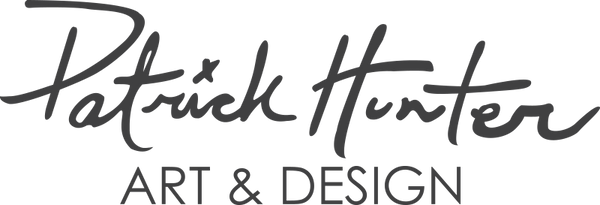Bold Lines, Bright Future — The Bay
Share
Ojibway artist Patrick Hunter on
seeing Canada through a different lens.

Originally published on The Bay website.
WRITTEN BY KELLY BOUTSALIS
PHOTOGRAPHS BY SATY + PRATHA
Patrick Hunter is painting gold feathers with careful strokes, finishing touches to a bike helmet, while we chat from his home in Red Lake in Northwestern Ontario.
The 2-Spirit Ojibway artist and graphic designer spends most of his time in both this area, where he is inspired by the lakes and wilderness, before returning to his apartment studio in Toronto to paint the landscapes and animals he’s often commissioned to make.
The in-demand artist works in multiple mediums, and has a distinctive style that is influenced by two formidable groups of Canadian artists. He describes his work as “if the Group of Seven and the Woodland art form had a baby.”
“There’s a lens [through which] people can see the country in a different kind of way, in a different light,” Hunter says of the Group of Seven, a cohort of influential landscape painters prolific during the 1920s and 1930s. “I’m pretty sure that they were seeing the same sort of thing that I see, and [that] I try to invoke in my work, which is seeing nature and painting the spirit of it.”

Growing up in Red Lake, Hunter was surrounded by the work of Woodland art, which is characterized by bright colours, bold black lines, and combining all living things — plants, humans and animals, that was originated by Ojibway artist Norval Morrisseau. But it took a great art teacher in high school to make sense of it for him.
“They said, ‘Try to imagine if you have spiritual goggles that you can see their soul or the spirit,’ and then it really started to work its way through my art style,” he explains.
As for that bike helmet, he’s gotten requests to do more work like this ever since his design appeared on the helmet of NHL goalie Marc Andre Fleury. The thoughtfully chosen feathers and flowers are hallmarks of both Hunter’s work, and that of Woodland artists.
“I’ve been getting a lot of fulfillment out of connecting with thousands of people, just filling in
some blanks for them in a way that doesn’t come from a place of shame.”
The NHL helmets are just the feather in the cap (excuse the pun) of Hunter’s growing roster of impressive and extremely Canadian clients. His work has appeared on the world stage, on the jerseys of the Canadian Olympic curling team in Beijing, and on Fleury, the Quebecois goaltender. It continues to go beyond borders, with his digital art appearing in Chicago’s United Center arena, where it is presented in Chicago Blackhawks’ land acknowledgement package.
As an Ojibway artist, accepting these opportunities doesn’t come lightly. He considers how meaningful it is to see Indigenous art in the mainstream for all generations.
“I always try to operate from how this is going to be impactful for not just non-Native people, but Indigenous people as well,” says Hunter. “I try to operate from a place where little kids can see the helmet on Marc Andre, or, on the flip side of that, Elders or grandparents seeing it done in a way that is respectful, rather than them being chased out of arenas or games, or Indigenous players being taunted.”
It’s this responsibility he’s placed upon himself that also seeps into who he chooses to work with. It requires thoughtfulness. With the Chicago Blackhawks work, it struck a chord that a major organization like that was figuring out how to become better allies to Indigenous people.
“There’s a little bit of an integrity checklist that I go through,” he says. “The Chicago Blackhawks have a very problematic logo, but they are in the process of figuring out how to go about changing that and are doing a lot of community work around Chicago with First Nation communities there.”


Having opportunities and relationships on this level is something that Hunter credits to embracing all parts of himself, which are celebrated this June, with Indigenous History Month and Pride Month. “In the beginning, I was hiding that I was LGBT, and Indigenous,” he says. Hunter is now a member of the Canadian Council for Aboriginal Business, and the Canadian Gay & Lesbian Chamber of Commerce.
“The world opened up when I got really real and let that shine through the work. I’m excited to see where it all can go,” he says. “But I think it’s important for people to remember that not that long ago, Indigenous and gay people weren’t allowed to have businesses.”
That reminder is a hallmark of Hunter’s approach to educating non-Indigenous people about Canada’s past. While delivering his popular painting workshops across the country, he often mentions a list of Indigenous people to follow on social media, or a documentary people should watch.
“I’ve been getting a lot of fulfillment out of connecting with thousands of people, just filling in some blanks for them in a way that doesn’t come from a place of shame,” he says. “Sometimes the conversation is pretty surface-level, but sometimes we get into a lot of deeper conversations about cultural appropriation or the Coles Notes version of the education system.”
“I love the reach that I’ve been able to [have],” he says. “At least they know a little bit more about painting, and Indigenous culture and that’s something I’ve been pretty proud of.”
